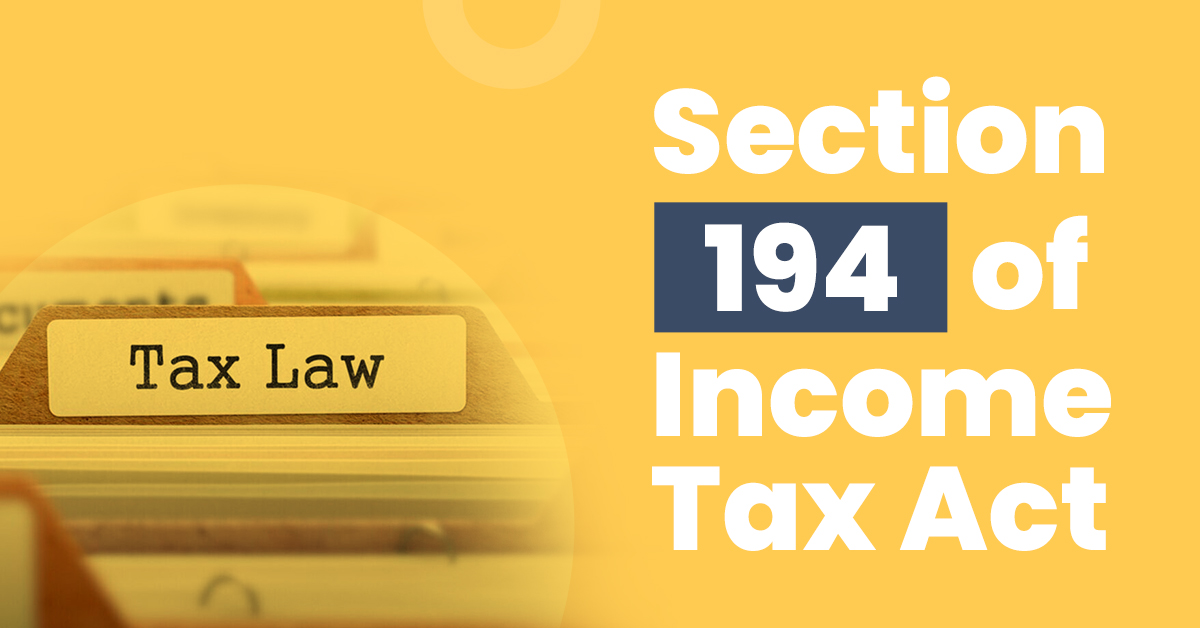Section 194: 2023-24 Guide On Section 194 Of The Income Tax Act


To make the tax collection process smoother and more efficient for taxpayers, tax deductions at the point of earning have been integrated into the Income Tax Laws. Such a process is known as Tax Deducted at Source (TDS).
The Finance Act, 2020 amended the provisions of Section 194 of the Income Tax Act. Earlier, dividend income declared, distributed, and paid by a domestic company used to be exempt under section 10(34) of the Income Tax Act.
Section 194 deals with tax deductions on income arising out of dividend stocks. In this article, taxpayers will understand the meaning of this section, including the tax rate, exceptions, and applicability. The rate of deduction of tax in respect of such dividend income is 10%. However, if you receive the dividend payment in cheques and the amount is up to ₹ 5000, TDS is not deducted. There are other exceptions which will be covered in this article later. Read more to know!
TDS on Dividend Under Section 194: Know More About It
Let’s be honest; we all love dividends. Many of our family members and acquaintances buy shares of large corporations and expect huge returns in the form of dividends. In simple terms, a dividend is the share of the profit of a shareholder in a company.
If you have purchased a company’s shares, you must aim for a good return and profit from it in the form of increased share price or dividends. This is where comes the role of section 194. This section demands a tax deduction at source (TDS) on such dividend income of shareholders.
Please note that up to Assessment Year 2020-21, the taxpayers who were domestic companies were subject to Dividend Distribution Tax (DDT) under section 115-O. Therefore, such dividend income was not subject to tax deduction at source under section 194. However, The Financial Act 2020 has removed DDT and transitioned to the traditional system of taxation where the dividends are taxed in the hands of the investors.
Applicability of TDS Under Section 194
The principal officer of a domestic company who is liable to make arrangements for the payment of dividends to shareholders is liable to deduct tax on such dividends distributed or paid. Such a principal officer has to be a resident of India to be eligible for deducting tax at source.
Now that you have understood the applicability of section 194, It would be pertinent to move a step forward and know when should such TDS be deducted.
1. When the payment is being made to the payee or,
2. When the amount is credited to the account of the payee,
whichever is the earlier of the two.
Tax Rate Under Section 194
The rate of TDS concerning such dividend income is 10%. However, this provision applies to those people who have provided their permanent account number (PAN) to a deductor. Those who still need to provide their PAN will attract a TDS rate of 20%.
The tax deduction must be made before making any payment concerning dividends by any mode. Or making any payment or distribution to any resident shareholder of any amount deemed as a dividend under section 2(22) (a)/(b)/(c)/(d)/(e).
Non-Applicability of TDS
No tax is to be deducted in case of a shareholder who is an individual, where –
- The dividend is paid by any mode other than cash; and
- The amount of such dividend or aggregate of dividend distributed or paid or likely to be distributed or paid during the financial year by the company to such shareholder does not exceed ₹ 5,000.
- The TDS provisions will not apply to such dividend credited or paid to LIC, GIC, subsidiaries of GIC, or any other insurer provided they own the shares or they have an entire beneficial interest in such shares – a business trust by a special purpose vehicle – any other person as may be notified by the Central Government.
Exceptions to TDS Under Section 194
According to section 194 of the Income Tax act, there are certain circumstances under which you can be exempted from paying TDS. Those circumstances are mentioned below:
- If your dividend income is covered under section 115-O.
- In case you receive the dividend payment in cheques and the amount is not more than ₹ 5000.
- You have self-declaration in form 15G/15H that your income falls below the basic exemption limit.
- When an income is paid to the business trust, then section 194 will not be applicable. You can find more about such norms in section 2, clause(13A) of the Income Tax Act.
Form 15H
To avoid TDS, you can use form 15H to declare that your income is below the taxable threshold. If your age is 60 and above (i.e. you are a senior citizen) and claiming receipts without deduction of tax, then you should file a declaration under section 197A, sub-section 1C of the Internal Revenue Code.
Form 15G
Form 15G is used by individuals and HUFs other than the company or firm to declare that their income is below the taxable threshold under Section 197A, subsection (1) and (1A) of the Internal Revenue Code.
Meaning of Section 2(22)(a), (b), (c), and (d) of the Income Tax Act
As per the Income Tax Act, sub-section 22 under section 2 deals with the definitions of dividends under the Income Tax Act.
Section 2(22)(a)- Distribution of assets deemed as dividend
The section states that dividend includes any kind of distribution by the company to its shareholders out of accumulated profit, whether it is capitalised or not. If such a situation
requires to release of all or any part of the assets of the company.
Section 2(22)(b)- Distribution of Debentures etc. deemed as dividend
It says that dividend includes any distribution to its shareholders by the company of debentures, deposit certificate or debenture-stock in any form, with or without interest and any distribution to its preference shareholders in the form of bonus.
Section 2(22)(c)- Distribution of assets on liquidation deemed as dividend
This section states that any distribution to its shareholders by the company on its liquidation, to the proportion to which such distribution is traceable to the accumulated profit of the company right before its liquidation, whether capitalised or not will be deemed as a dividend.
Section 2(22)(d)- Distribution on Reduction of Share Capital Deemed as Dividend
It implies that any distribution to its shareholders by the company on reducing its capital to the extent to which the company possesses accumulated profits, whether capitalised or not, will be deemed as dividends.
Section 2(22)(e)- Loans or advances made to shareholders out of accumulated profits
This section states that if any closely held company offers loans and advances to a shareholder with over 10% voting power, where the shareholder is interested or for their benefit, it is considered a dividend.
Time Limit to Deposit TDS Collected
The tax deducted at source throughout the financial year should be deposited to the government, not after the 7th of the month following a month. However, an exception to this is the month of March. The TDS for the month of March should be deposited no later than April 30 of the next financial year.
Deduction At Source and Advance Payment
The total income of an assessee for the previous year is taxable in the relevant assessment year. For example, the total income for the P.Y. 2021-22 is taxable in the A.Y. 2022-23. However, income tax is recovered from the assessee in the previous year itself through –
(1) Tax deduction at source (TDS)
(2) Tax collection at source (TCS)
(3) Payment of advance tax
Another mode of recovery of tax is from the employer through tax paid by him under section 192(1A) on the non-monetary perquisites provided to the employee. These taxes are deductible from the total tax due. The taxpayer, while filing his return of income, has to pay self-assessment tax under section 140A, if tax is due on the total income as per his return of income after adjusting, TDS, TCS, relief of tax claimed under section 89, relief of tax claimed under section 90, 90A or 91 on account of tax paid in a country outside India or specified territory outside India, tax credit claimed to be set off and advance tax.
Final Thoughts
In this article, you must have got some insights about section 194 of the Income Tax. To summarise it can be said that the system of tax deductions at the point of earning was introduced to make the tax collection system more efficient.
Section 194 deals with the income arising from the dividends of the stock and tax liabilities arising from it. Earlier dividend income was exempted from any kind of tax, but the Finance act of 2020 amended this provision.
The rate of TDS regarding dividend income is 10% and you should make sure that you have provided your PAN details, failing which can attract a TDS rate of 20%. However, TDS also have some exceptions like if your dividend income is covered under section 115-O, In case you receive the dividend payment in cheques and the amount is not more than ₹ 5000.
The provisions of TDS also do not apply to the dividend paid to LIC, GIC, subsidiaries of GIC or any other person notified by the Government of India.
Frequently Asked Questions
What is the rate of TDS for non-resident shareholders?
Other than Foreign Portfolio Investment (FPI), the TDS rate for non-resident shareholders is 20% and an additional surcharge is also applicable. You should also be aware of the fact that the surcharge rate is a maximum of 15% in this case.
Whom should I contact for a lower TDS deduction?
You should contact the assessing officer by applying a lower TDS deduction. After considering several provisions of rule 28AA of the Income tax act.
Is TDS deducted from the interest received from the bank?
If your interest income from the bank is more than ₹10000, then a 10% TDS will be deducted. However, the union budget 2019 has increased this threshold to ₹ 40000 (₹ 50000 for senior citizens). You should also remember that if you have not provided your PAN details to the bank, the rate charged will be 20% of such interest income.
Although TDS was not shown in 26AS, can I still receive credit for it? Yes, but how?
If the TDS is not shown on Form 26AS, it means that the deductor has not deposited it with the government. In this situation, you must file a TDS return and request that the deductor refund the money to the government.




